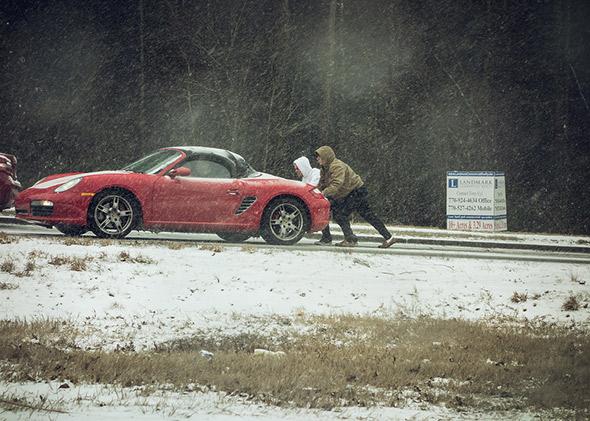Thought you had a bad day yesterday? At least you’re not waking up this morning in the cereal aisle at Kroger.
Tens of thousands of people across the South were stranded overnight as rare snow and ice blanketed the region and paralyzed transportation. Though totals were light by northern standards, the impact quickly became legendary.
About 800 students were stuck in schools overnight in Birmingham, Ala. Stuck commuters struggled to fill the time on the highways. One woman trapped in her car listened to the entire Hunger Games on audiobook, and when it was over she still wasn’t going anywhere. Joe Weisenthal at Business Insider predicts the ensuing chaos “will likely go down as one of the worst traffic jams in American history.”
No more snow’s expected in the immediate future, but that doesn’t mean all is well in the fair South. The leftover ice currently handicapping travel isn’t going anywhere anytime soon. For example, temperatures won’t make it to the freezing point until Thursday afternoon in Atlanta. That’s a 60-hour consecutive string of frigidity, since late Monday night.
The Weather Channel has a useful state-by-state roundup of the worst impacts so far.
Those from more northern climates may be forgiven for being baffled by how this could have happened from a measly two inches of snow. As best I can tell, here’s the timeline:
Monday, 4:53 a.m.: The National Weather Service in Atlanta issues a Winter Storm Watch, advising people to be prepared for around 0.5 to 2 inches of snow.
Tuesday, 3:39 a.m.: The National Weather Service in Atlanta upgrades the area to a Winter Storm Warning, predicting 1 to 2 inches of snow later in the day.
Tuesday, 12 p.m.–5 p.m.: About 2 inches of poorly timed snow falls across metro Atlanta, compacting into ice as temperatures dropped into the low 20s and teens throughout the evening, turning highways into skating rinks. People try to make it home from work early.
Tuesday, 1:45 p.m.: Fulton County schools suddenly announce via email they will close for the rest of the day, prompting many parents to head to the roads to pick their kids up. Gridlock hits critical mass, with traffic jams blocking progress every few hundred feet.
Tuesday, early afternoon: Local liveblogs begin to chronicle the descent into anarchy that was formerly known as the Atlanta-area highway system.
Tuesday evening: Still stuck on the highways, many schools give up and stop trying to bus students home. The slumber party to end all slumber parties begins.
Wednesday, 4:10 a.m.: Despite no additional snow or ice expected, the National Weather Service in Atlanta extends the Winter Storm Warning for the Atlanta area due to “major road impacts,” warning drivers that “travel will continue to be dangerous or impossible. Only travel in an emergency.” I’ve never seen this particular action taken before.
So who is to blame for this apocalyptic chaos? In this case, meteorologists are off the hook.
Marshall Shepherd, president of the American Meteorological Society (which, coincidentally, is holding its annual meeting in Atlanta starting this weekend), opined, “the buses had a tough time getting kids home, but meteorologists should not be thrown under the bus.” Warnings were issued well in advance, and in plain language. In fact, weather models were giving hints of a rising risk of winter weather in Atlanta as early as Sunday.
But the school systems could also be grudgingly forgiven—even in the Deep South, where snowplows are as rare as palm trees in Minnesota—for not quickly canceling school on an outlook showing just an inch or two of snow. From the Atlanta Journal-Constitution: “The forecast wasn’t reliable enough Monday night or Tuesday morning to justify canceling school at that time, said Fulton Schools Superintendent Robert Avossa.”
There was a tough yes-or-no call to make early on, and many schools chose the wrong one. It happens. Unfortunately, a car-centric city like Atlanta just couldn’t keep up with the chaos once everyone realized what was happening.
It’s true the forecast was especially uncertain in the Atlanta area as the storm took shape on Monday. But when you’re forecasting a once-in-10-years event, of course the forecast is going to look uncertain. That’s the thing with extreme weather: It’s extreme. In this case, the storm performed pretty much exactly as forecast, nearly 36 hours in advance.
There was at least one person who did seem asleep at the wheel, and that’s Nathan Deal, the governor of Georgia. Midstorm, he was at a political luncheon. We know, because he signed this tweet himself:
At a press conference later in the day, he said:
“As you know, we have been confronted with an unexpected storm that has hit the metropolitan Atlanta area.”
This storm was not unexpected. It’s a pet peeve of mine when scientists do a good job and get blamed for it. Parents, schools, and ordinary commuters also did what they thought was best to take care of their families in what was by all accounts a frightening and stressful day. Unfortunately, the sum total of everyone’s actions led to mass chaos.
As a meteorologist, this is a perfect example of why I like to focus on realistic worst-case scenarios. That way, we can all be prepared in case it comes to pass. It also forces people to think: What would I do if we get twice the expected snowfall? What if the flooding actually reaches my front steps? In an age of increasingly wild weather, it helps to stay on your toes.
Future Tense is a partnership of Slate, New America, and Arizona State University.
